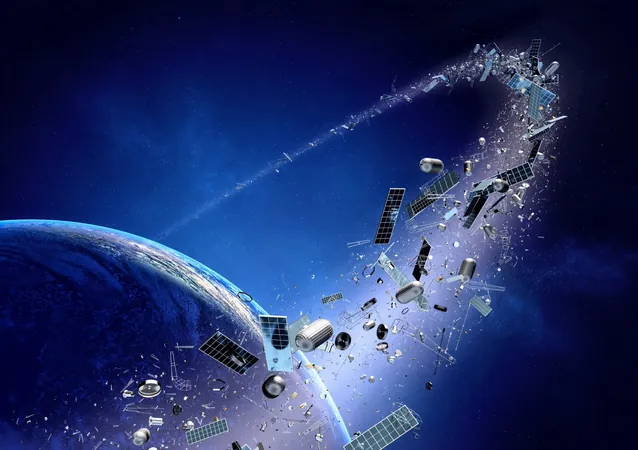
The Alarming Rise of Space Junk: Are We on the Brink of Kessler Syndrome?
2025-01-04
Author: Wai
On October 19, 2023, the US Space Command reported a disturbing event: the Intelsat 33e satellite disintegrated into around 20 fragments, exacerbating the already congested orbit around Earth.
With the exact cause of this breakup remaining a mystery, experts are increasingly alarmed about the mounting issue of space debris in Low Earth Orbit (LEO).
What Exactly is Low Earth Orbit (LEO)?
Low Earth Orbit is a valuable space zone that extends approximately 100 to 1,200 miles (160 to 2,000 kilometers) above our planet.
Due to its proximity to Earth, LEO is the preferred operating zone for various satellites, including those utilized for communication, Earth observation, and the International Space Station (ISS), which hovers around 250 miles (400 kilometers) above ground.
Satellites in LEO have fast orbital speeds, completing their journey around Earth in about 90 minutes.
This unique characteristic enables them to repeatedly pass over the same regions of the Earth multiple times a day, which is essential for tasks ranging from weather monitoring to global communication.
Introducing Kessler Syndrome
In 1978, NASA scientists warned of what is now known as Kessler Syndrome—a runaway effect caused by collisions in space that increase debris, leading to more collisions and a cascade of catastrophic events.
If unchecked, Kessler Syndrome could render LEO unusable for future satellite launches, severely disrupting technologies reliant on space systems, such as GPS, telecommunications, and climate monitoring.
John L. Crassidis, a leading expert in space debris from the University at Buffalo, cautioned, "If collision probabilities continue to rise to a point where satellites can no longer be safely launched, we're headed for major trouble."
The Escalating Problem of Space Debris
Currently, over 10,000 active satellites orbit our planet, and this number is poised to escalate dramatically.
A significant portion of these—approximately 6,800—belong to Elon Musk’s Starlink network, which plans to roll out thousands more.
The increased satellite traffic raises the likelihood of accidents.
Since the onset of the space age in 1957, there have been over 650 incidents that resulted in the fragmentation of various satellites or spacecraft, including Russia's 2021 destruction of its own satellite, which generated more than 1,500 pieces of debris.
According to Bill Therien, a CTO at ExoAnalytic Solutions, tracking debris size greatly varies, from fragments the size of softballs to those comparable to a car door. The majority of debris consists of smaller particles, complicating detection efforts.
The Risks of Space Debris
The ongoing congestion in LEO poses significant threats, especially to manned missions like the ISS, which has had to perform numerous evasive maneuvers to avoid collisions with debris.
A recent scare involved a piece of debris that came within 2.5 miles of the ISS, necessitating adjustments from an onboard Russian spacecraft.
The fallout from a significant collision could be seismic: disruptions to satellite-based services like GPS and internet could impact countless aspects of daily life.
This is a precarious reality that lies ahead without immediate change.
Taking Action Against Kessler Syndrome
Fortunately, organizations like the European Space Agency (ESA) are taking strides to tackle the space debris crisis through projects such as Clearsat-1, aimed at capturing non-functional satellites for safe deorbiting.
Innovative technologies like drag sails have also emerged, designed to accelerate the descent of derelict objects.
However, tracking space debris poses an enormous challenge. ESA estimates that there are over 40,500 pieces of debris larger than 10 centimeters, alongside millions of smaller fragments that remain virtually invisible to current tracking systems.
Call for Urgent Regulations
Experts agree that a cooperative international response is vital, emphasizing the need for robust regulations to govern space traffic management.
The United Nations’ Pact for the Future aims to lay down rules to mitigate space debris, yet enforcement remains precarious.
Dr. Vishnu Reddy, a planetary science professor at the University of Arizona, stated, "The absence of regulation is the biggest worry. Establishing norms and guidelines within the satellite industry can aid in alleviating the problem."
Conclusion: A Future at Stake
As we stand on the brink of a potential Kessler Syndrome scenario, it’s critical to recognize the severe risks posed by escalating satellite launches without adequate debris management.
With over 10,000 satellites currently orbiting Earth and more set to join them, the need for immediate action has never been clearer.
Proactive steps—including technological innovations and international regulations—are essential in protecting our access to space.
Without thorough efforts to combat this crisis, the repercussions could be disastrous, threatening the foundations of space exploration and various facets of modern life heavily reliant on satellite technology.

 Brasil (PT)
Brasil (PT)
 Canada (EN)
Canada (EN)
 Chile (ES)
Chile (ES)
 Česko (CS)
Česko (CS)
 대한민국 (KO)
대한민국 (KO)
 España (ES)
España (ES)
 France (FR)
France (FR)
 Hong Kong (EN)
Hong Kong (EN)
 Italia (IT)
Italia (IT)
 日本 (JA)
日本 (JA)
 Magyarország (HU)
Magyarország (HU)
 Norge (NO)
Norge (NO)
 Polska (PL)
Polska (PL)
 Schweiz (DE)
Schweiz (DE)
 Singapore (EN)
Singapore (EN)
 Sverige (SV)
Sverige (SV)
 Suomi (FI)
Suomi (FI)
 Türkiye (TR)
Türkiye (TR)
 الإمارات العربية المتحدة (AR)
الإمارات العربية المتحدة (AR)